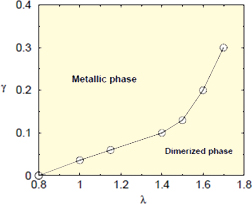Effects of Anharmonicity in 1-D Electron-Phonon System
K. Ueda Group
There is a growing interest in the effects of anharmonicity of ion vibrations. Experimentally superconductivity was found in β-pyrochlore compounds and it seems that anharmonic ion vibrations are responsible both for their superconductivity as well as some of unusual properties in the nomal phase. Recent experiments on NMR of KOs2O6 shows that the NMR relaxation rate is dominated by the vibrations of K ions in the cage of OsO networks. Such ion vibrations confined in cages are called rattling modes. The unusual temperature dependence of the NMR relaxation rate is explained by the effects of rattling modes [1].

Fig.1. Phase diagram of the one-dimensional spinful Holstein model with anharmonicity in the (λ,γ)-plane where λ is an electron-phonon coupling constant and λ is the coefficient of the quartic term of the potential.
Even if the ion vibrations are well localized they are coupled each other via electron-phonon couplings and/or phonon-phonon couplings. Concerning the latter couplings between the localized phonons and extended ones are considered. As a first step to study effects of the former type of couplings we have studied the one dimensional Holstein model with anharmonicity [2]. In the Holstein model the ion-electron coupling is given through the modulation of energy level of the electron orbitals. Therefore in this model A1 mode of ion vibrations is considered.
Concerning the standard Holstein model without the anharmonicity, a consensus has been built that the ground state is always the dimerized CDW state for the spinless case while there is a phase transition between the metallic state and the dimerized CDW state at a finite coupling constant. We have studied the model with the anharmonicity by using the determinant quantum Monte Carlo Simulations.
The obtained ground state phase diagram is shown in Fig. 1. One can see that the anharmonic quartic term tends to stabilize the metallic phase, while the anharmonicity represented by the negative quadratic term, a double well potential, favors the dimerized CDW phase. Studies on charge and spin correlation functions reveal that the metallic phase is a Luther-Emery liquid with gapless charge excitations and gapful spin excitations. In the dimerized CDW phase both spin and charge excitations are gapful.
References
- T. Dahm and K. Ued,: Phys. Rev. Lett. 99 187003 (2007).
- J. Zhao and K. Ueda, to be published in J. Phys. Soc. Jpn (2010).
